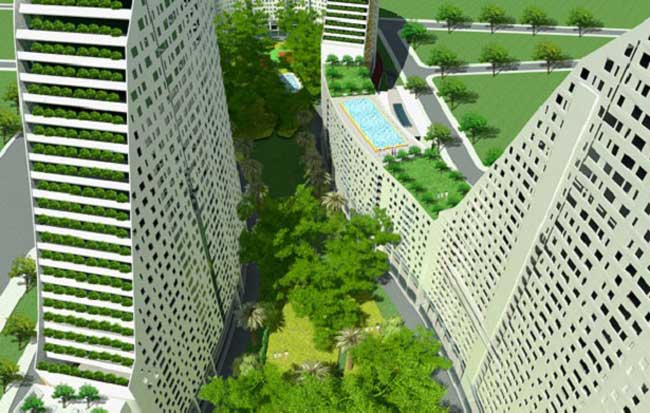Going green to save a bundle

illustration photo
However, the initial investment cost remains an obstacle to green building development. Worries are over how prohibitive this initial outlay is. Are green buildings really that much more expensive than conventional buildings?
There is a loose figure bandied about that the construction of a green building is 10 to 20 per cent more expensive than that of a conventional building. This figure is mostly groundless, and reflects the fact that much of the data available regarding costs in a fledging market like Vietnam is based on rough estimates. At the same time, it highlights the reluctance of project developers to ‘going green’.
On a global scale, diverse studies indicate that the investment cost of green buildings may vary, depending on the desired energy saving benefits. Having said that, the Green Building Construction Association’s (GBCA) 2012 appraisal report stated that the investment cost of green buildings could be a maximum of 4 per cent higher than the initial investment cost projected for similar conventional buildings. This was reiterated by the Singapore Construction Ministry who calculated the extra cost for green buildings to be at most 5 per cent higher than similar conventional buildings (2011-2012 annual report summarising Green Mark-certified buildings).
According to Melissa Merryweather, southern co-ordinator of the Vietnam Green Building Council (VGBC), in her appraisal of 11 green buildings with either the LEED (Leadership in Energy and Environmental Design) or [Vietnamese] LOTUS certification, the extra cost of green design in Vietnam was only 0.5 to 2.6 per cent higher than a conventional building.
Specifically, the Little Flowers kindergarten in the southern province of Dong Nai, which holds a Silver LOTUS certification and is owned by Taiwanese-invested Pouchen Vietnam Company saw its investment costs rise just 1.8 per cent over the costs for a standard structure. Similarly, Vietnam Moc Bai JSC in the southern province of Tay Ninh – another LOTUS winner – saw its investment costs come up by just 2 per cent only.
Cementing this perspective, technical studies on Vietnam’s green buildings by the International Finance Corporation (IFC) show that with a mere 2-4 per cent in extra investment costs, green buildings could save 25-30 per cent in electricity and water usage expenses once operational.
Despite the proven long-term advantages of green building, the investment cost is still a stumbling-block that most developers are unable or unwilling to see past. Also, with real and invented figures floating contradicting each other, it can be hard for developers to accurately estimate the actual returns of green ventures.
Keenly aware of the developers’ concerns, the IFC has initiated the Excellence in Design for Greater Efficiencies (EDGE) tool-set specifically tailored to developing countries, such as Mexico, Indonesia, South Africa, Lebanon, and Vietnam.
This is a simplified green building certification tool set which has focused on three ‘simple’ criteria, which have massive economic and environmental benefits for a building: reduced usage of energy, water, and materials.
Concrete measures have been put in place to help developers meet these criteria, thus helping developers to easily select the option that best fits their financial conditions.
The ‘green’ measures suggested by the EDGE tool do not require costly investment. Nguyen Ngoc Thanh, Design director of Nam Long Group JSC, the developer of BridgeView block – the first block in Vietnam awarded with IFC’s EDGE certification – said “Applying the EDGE design standards only increased our construction costs by 1.2 per cent, which is reasonable for both the developer and customers, especially when each month the tenants can save at least 20 per cent on their electricity and water bills.”
The proven advantage of EDGE is the calculation software which is totally free-of-charge and meticulously designed to help developers grasp investment costs as well as financial benefits when applying each ‘green’ solution for their buildings.
Nguyen Bac Vu, architect at designing firm Ardor Architects said, “We look forward to using tool-sets that can support green building design efficiently, like EDGE. As well as delivering ‘green’ solutions, it also indicates the financial and environmental benefits when it is applied. This will help spur the designing process and create a common voice between the architects and the developers.”
The EDGE tool means that going green in construction is something that doesn’t have to be expensive. The proven economic and ecological benefits of green buildings could produce a ‘domino’ effect, inspiring other developers to follow suit, and helping Vietnam to move closer to achieving its national green development target.
What the stars mean:
★ Poor ★ ★ Promising ★★★ Good ★★★★ Very good ★★★★★ Exceptional
Latest News
More News
- The Kross ascends in Ho Chi Minh City's business heart (October 10, 2025 | 17:16)
- ESG-driven sustainability to define Vietnam’s green real estate (September 19, 2025 | 11:35)
- Tan Thuan Tower open for high value-added and innovative tenants (September 10, 2025 | 10:00)
- The new home of modern business at Hanoi's Starlake (August 19, 2025 | 08:00)
- Forum focuses on financial solutions for ESG in real estate (June 18, 2025 | 12:12)
- Frasers Property Vietnam moves towards green real estate leadership (May 08, 2025 | 11:25)
- Keppel collaborates with leading brands to enhance urban living in Vietnam (April 04, 2025 | 09:26)
- Strengthen partnership and efforts to promote zero energy buildings in Vietnam (February 26, 2025 | 17:31)
- Haus Dalat ESG real estate project holds opening ceremony (February 24, 2025 | 11:12)
- Best golfers awarded at Swing for the Kids 2024 (October 13, 2024 | 08:00)


















 Mobile Version
Mobile Version